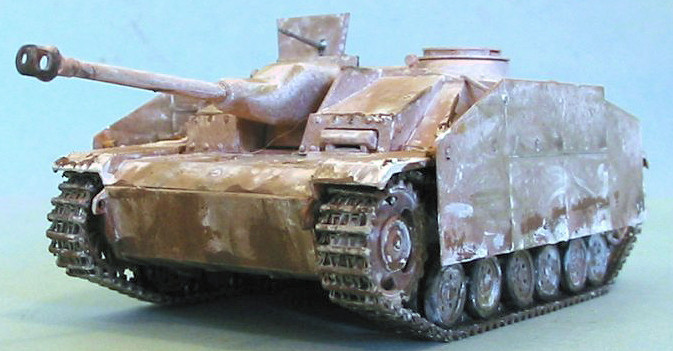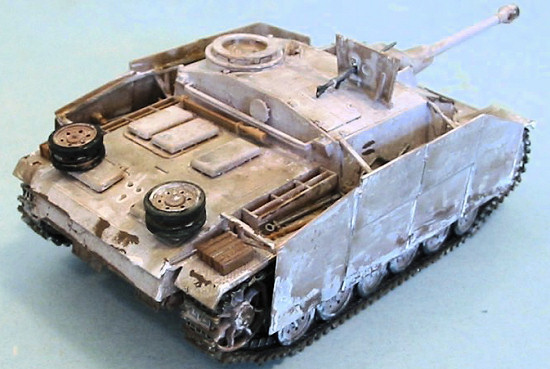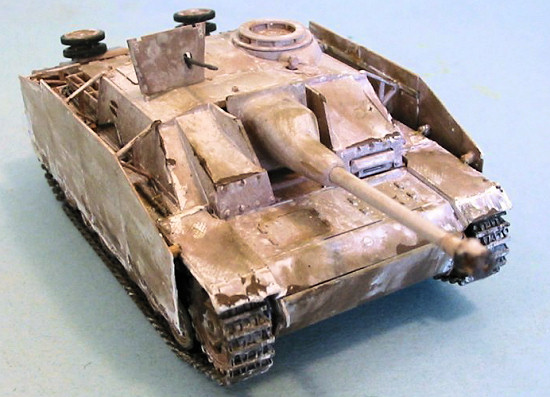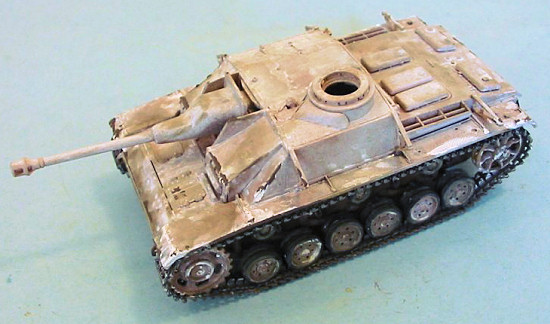
Tamiya 1/35 Stug III Ausf G
| KIT #: | ? |
| PRICE: | 1700 yen at www.hlj.com |
| DECALS: | Two options |
| REVIEWER: | Tom Cleaver |
| NOTES: |

| HISTORY |
The Sturmgeschutz III series was one of the most successful German armored
fighting vehicles used during the Second World War, serving on all fronts as
assault guns and tank destroyers in both offensive and defensive modes. The
Sturmgeschutz III, with its low silhouette, was a difficult target and a
dangerous opponent. As a result, Sturmgeschutz crews were considered the elite
of t he artillery, being issued special field grey uniforms. The Sturmgeschutz
units had an impressive score of tank kills, with some 20000 enemy tanks
credited to them by the spring of 1944. By the end of the war in April 1945,
1,053 Stug III Gs and 277 Stug III Hs were still in service, while
approximately 9,500 Sturmgeschutz IIIs of all sub-types were produced from
1940 to March of 1945 by Alkett, with a few hundred more produced by MIAG.
he artillery, being issued special field grey uniforms. The Sturmgeschutz
units had an impressive score of tank kills, with some 20000 enemy tanks
credited to them by the spring of 1944. By the end of the war in April 1945,
1,053 Stug III Gs and 277 Stug III Hs were still in service, while
approximately 9,500 Sturmgeschutz IIIs of all sub-types were produced from
1940 to March of 1945 by Alkett, with a few hundred more produced by MIAG.
Assault guns like the Sturmgeschutz were cheaper and less time consuming to produce than standard turreted tanks. The cost of a Sturmgeschutz III Ausf G was 82,500 Reichmarks, compared to 103,163 Reichmarks for the PzKpfw III Ausf M and 115, 962 Reichmarks for the PzKpfw IV Ausf F2. Nearly four Stug III Ausf Gs could be produced for the cost of one King Tiger.
The Stug III series resulted from a 1935 proposal by then-Colonel Erich von Manstein, that Sturmartillerie units be formed for direct support of infantry divisions, equipped with assault guns mounted on a tracked chassis. Accompanying the infantry, the assault gunís main task was to knock out pill-boxes, machine gun nests, anti-tank guns and other obstacles.
Daimler-Benz AG began work on an armored infantry support vehicle mounting 75mm gun on June 15 1936. The gun was to be mounted in a superstructure that provided full protection for the crew. Since Daimler-Benz AG was already involved in the development and production of the Panzerkampfwagen III, it was decided to use this chassis and components for the new vehicle.
The first production vehicles were based on the Panzerkampfwagen III Ausf F chassis and components, and entered production in 1940, carrying the 75mm StuK 37 L/24 gun. These first saw service during the French campaign.
 In August 1940,
Sturmartillerie units were organized in Abteilungen (battalions) with
18 assault guns in three batteries These were renamed Sturmgeschuetz
Abteilungen in early 1941. That April, Sturmgeschuetz Abteilungen
were increased to 21 guns in three batteries of 7. In 1942, following the
introduction of the long-barrelled Stug III Ausf G, armed with either the 75mm
L/43 or L/48), Sturmgeschuetz Abteilungen were reorganized, with the
number of assault guns increased to 28 per battalion. In November, 1942,
Sturmgeschuetz Abteilungen were again reorganized and the number of assault
guns was increased to 31 per battalion with three additional assault guns for
battery commanders. This f organization was referred to as a Sturmgeschuetz
Brigade, and remained in use until the end of the war.
In August 1940,
Sturmartillerie units were organized in Abteilungen (battalions) with
18 assault guns in three batteries These were renamed Sturmgeschuetz
Abteilungen in early 1941. That April, Sturmgeschuetz Abteilungen
were increased to 21 guns in three batteries of 7. In 1942, following the
introduction of the long-barrelled Stug III Ausf G, armed with either the 75mm
L/43 or L/48), Sturmgeschuetz Abteilungen were reorganized, with the
number of assault guns increased to 28 per battalion. In November, 1942,
Sturmgeschuetz Abteilungen were again reorganized and the number of assault
guns was increased to 31 per battalion with three additional assault guns for
battery commanders. This f organization was referred to as a Sturmgeschuetz
Brigade, and remained in use until the end of the war.
Towards the end of the war, Stugs were frequently issued to other units as replacements for tank destroyers and even tanks, with the Stug III used as replacements for the PzKpfw III and PzKpfw IV and even the PzKpfw V Panther in Panzer Abteilungs. This was a mistaken use of the vehicle, but the desperate situation and the overall shortage of tanks made it necessary.
The Sturmgeschutz III Ausf G entered production in December 1942 and remained in production until March/April 1945, making it the most numerous of all Sturmgeschutz III guns, with 7,893 were produced by Alkett (Altmaerkische Kettenfabrik GmbH) and MIAG (Muehlenbau-und-Industrie AG). Peak production was during 1944, when 4,013 Stug III Ausf Gs left the factories. Overall, Alkett produced over 5000 Ausf Gs, while MIAG - which began production in March1943 - produced 2,800.
| THE KIT |
 This new
kit from Tamiya best represents the Mid-Production Model G, which was produced
from April 1943 to May 1944. The kit has the Mid-Production Model G welded 80mm
front hull armor and the single piece bolted armor plate over the driverís visor
and bolted armor panel on the right front of the superstructure. The kit
provides the early style schurzen armor panels. The kit also includes the
initial cast Saukopf mantlet introduced in November 1943, without the
coaxial machine gun opening that was added in October 1944, as well as the final
round profile muzzle brake.
This new
kit from Tamiya best represents the Mid-Production Model G, which was produced
from April 1943 to May 1944. The kit has the Mid-Production Model G welded 80mm
front hull armor and the single piece bolted armor plate over the driverís visor
and bolted armor panel on the right front of the superstructure. The kit
provides the early style schurzen armor panels. The kit also includes the
initial cast Saukopf mantlet introduced in November 1943, without the
coaxial machine gun opening that was added in October 1944, as well as the final
round profile muzzle brake.
The kit consists of 240 parts in light tan plastic with a selection of poly caps for the wheels and screws to attach the upper hull to the diecast lower hull, plus the decal and instruction sheets.
The kit includes several sprues from previous kits with sprue A from the Stug III Ausf. B, while sprues D, E, P & U are from the recent Panzer III Ausf. L. New sprues G and R are added for the Ausf. G. The kit uses the same metal lower hull tub from the previous Stug B and Pzkw III kits.
| CONSTRUCTION |
I started by painting the tracks with Model Master Steel. I then painted all the wheels with Tamiya Panzer Yellow. I gave all this a wash of thinned Tamiya Red Brown when that was dry, then hand painted the rubber on the road wheels.
With the tedious part of construction completed, I moved on to assemble the main parts of the upper hull, other than the tools and such which would be added later.
| COLORS AND MARKINGS |
Painting:
 I
painted the model overall Panzer Yellow, followed by the brown wash to pop out
detail. I then gave the model a coat of thinned Tamiya Flat White to start the
process of applying a worn winter camouflage.
I
painted the model overall Panzer Yellow, followed by the brown wash to pop out
detail. I then gave the model a coat of thinned Tamiya Flat White to start the
process of applying a worn winter camouflage.
I had just received the Tamiya Weather Master sets, and decided to use them in this project. I used this muddy-up the hull and wheels and tracks. I also muddied-up the Schurzen pretty thoroughly.
I assembled and attached the wheels to the lower hull, then assembled the tracks. I then screwed the upper hull onto the diecast lower hull.
Final weathering:
When this was done, I began some more weathering of the model, using the sticks for Mud and Snow to apply heavier coats. These are really nice, since once they are dry you can handle that area without damaging what weathering you have done. The weathering paint is all water-soluble, so whenever you think you have too much, you can just wash it off by dipping a brush in water and thinning it. If you do it with care, the end result is very realistic.
| FINAL BITS |
I attached all the tools, spare drive wheels, etc., then glued the Schurzen in position.
| CONCLUSIONS |
 This is a very easy kit to build. I have seen comments at armor modelerís
discussion boards that the kit may not be accurately any one particular
production sub-type of the Stug III Ausf G, but the end result looks good. For
me as a non-expert armor modeler, ďit looks like a Sturmgeschutz to me!Ē The
kit looks very nice sitting next to the Pzkw III. I had a lot of fun learning
to use the Tamiya weathering sets on this kit and think the result would look
quite convincing posed in a winter diorama.
This is a very easy kit to build. I have seen comments at armor modelerís
discussion boards that the kit may not be accurately any one particular
production sub-type of the Stug III Ausf G, but the end result looks good. For
me as a non-expert armor modeler, ďit looks like a Sturmgeschutz to me!Ē The
kit looks very nice sitting next to the Pzkw III. I had a lot of fun learning
to use the Tamiya weathering sets on this kit and think the result would look
quite convincing posed in a winter diorama.
Thanks to HobbyLink Japan for the review kit.
June 2006
If you would like your product reviewed fairly and quickly by a site that has over 300,000 visitors a month, please contact me or see other details in the Note to Contributors.